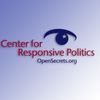By: Robert Maguire
In the long debate over the changing nature of election advertising, one thing is now clearer than ever: Outside groups that can raise and spend unlimited money -- sometimes without disclosing the sources of their funds -- make up a larger portion of election spending than at any point in the last 16 years, by far.
A new study co-authored by the Wesleyan Media Project and the Center for Responsive Politics provides the first ever analysis of ad-buy data from 2000 to the present cycle, tracking more than 700 ad sponsoring organizations, all of which have been standardized and coded according to their type and level of disclosure.
The term "outside group" generally refers to organizations that spend money in elections without coordinating their activities with the candidates themselves.
Independent groups are not new, but they haven't always been prominent ad buyers. In 2000, for example, voters saw fewer than 80,000 ads run by outside groups in federal elections -- a total that made up only about 10 percent of all of the ads run that cycle. By 2012, the total had ballooned to more than 880,000, more than a fourth of all of the ads run that election.
While candidates have always been, and still are, responsible for the majority of ads run in a particular cycle, that majority is being whittled away with each passing election. That's evidenced, the study notes, by the fact that some competitive House and Senate races are already seeing instances where outside groups, not candidates, are running the majority of ads "that mention or picture the candidates on the ballot."
The two main proponents of the growth in outside groups' overall share of election advertising are super PACs and politically active nonprofits. The former only came into existence in 2010, and since then has come to dominate the field, accounting for more than 72.7 percent of all outside group advertising so far in the 2016 cycle.
Politically active nonprofits, on the other hand, have been active in every cycle going back to 2000, but what may be the same in quality is not the same in quantity. These groups -- primarily 501(c)(4) social welfare organizations and 501(c)(6) trade associations -- are the driving force behind the growth in "dark money" in elections, thanks to a series of Supreme Court decisions that have loosened campaign finance regulations.
Proponents of laxer campaign finance rules have long made the case that the use of nonprofits as vehicles of political money is an old practice -- suggesting that what's happening is nothing new -- and at first glance this data would seem to bolster that claim. Groups like the Chamber of Commerce and Planned Parenthood were among the largest ad sponsors in the 2000 cycle. Even some of the more questionable groups, like Americans for Job Security, were active then, buying more than 6,000 ads in presidential and Senate races.
But this data shows conclusively, for the first time, that the shift towards using nonprofit groups as vehicles for anonymous political funds in federal elections is radical in its magnitude, not its mere existence. Between 2000 and 2006, nondisclosing groups averaged less than 18,000 ad spots per cycle. However, after the Supreme Court loosened campaign finance restrictions -- first in Wisconsin Right to Life v FEC in 2007, then in Citizens United v FEC in 2010 -- the average ad count for nondisclosing groups over the next four elections jumped to more than 219,000 per cycle.
The groups responsible for this growth in secret money are not primarily the more established nonprofits like the League of Conservation Voters or the National Rifle Association -- or union groups -- rather, they are primarily groups linked to political operatives or wealthy donors. In fact, out of all outside groups active over the last 16 years, no organization has run more ads than Crossroads GPS, a social welfare organization started by GOP political guru Karl Rove which alone has run more than 200,000 ads in federal elections since its founding in 2010, and funded many other groups that have done the same.
More than half of Crossroads GPS' ads have been run outside of FEC reporting windows and, as such, have often gone unreported to the Federal Election Commission. This is an increasingly common practice among dark money groups. By running "issue ads" that are often little more than thinly veiled political ads -- stopping short of asking viewers to vote for or against a particular candidate -- dark money groups can avoid reporting the spending to the FEC as long as the ads are run more than 30 days before a primary or 60 days before a general election. By avoiding such reporting, these groups can then explain away their political activity to the IRS as permissible issue advocacy to the IRS when they file their annual returns.
The study finds that dark money groups do indeed focus much of their efforts outside of the FEC's reporting windows. In the Senate for example, the share of advertising bought by dark money groups was larger outside the reporting windows in every cycle except for 2002, meaning that the growing amount of airings from dark money groups was coming during periods where that spending wouldn't necessarily be reported to the FEC.
The study released today shows that, for years, nonprofits have focused the bulk of their spending in that dark period, providing maximum impact with the least reporting. Some of the most prolific groups, like Americans for Prosperity -- the flagship group backed by the donor network headed by billionaire brothers Charles and David Koch -- ran more than 90 percent of their ads outside of these windows.
And once each election is over, most of these groups fade away. Just under 80 percent of the groups sponsoring ads in federal elections are only active in one cycle, though the operatives who run them often reappear as the captains of new outside groups in each new cycle.
